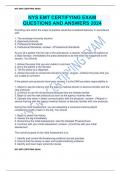NYS EMT CERTIFYING EXAM
NYS EMT CERTIFYING EXAM
QUESTIONS AND ANSWERS 2024
Providing care within the scope of practice would be considered behavior in accordance
with:
1. The sovereign immunity doctrine
2. Approved protocols
3. Professional Standards
4. Institutional Standards -answer- ✔Professional Standards
As you lift a patient into the rear of the ambulance, a reporter recognizes the patient as
a State Senator. Immediately the press demands to be told what has happened to the
senator. You Should:
1. Advise the press that you are unable to comment
2. Deny the patient is the Senator
3. Tell the press your diagnosis
4. Advise the press to contact the Senator's family -answer- ✔Advise the press that you
are unable to comment
If the patient care protocols have been revised, it is the EMS providers responsibility to
1. Attend in-service training with the agency medical director to become familiar with the
new protocols
2. Continue to use the old protocols because they are already familiar
3. Begin to use the new protocols as soon as the agency receives them
4. Operate only when in direct communication with the physician -answer- ✔Attend in-
service training with the agency medical director to become familiar with new protocols
During the Initial Assessment, you are assessing a conscious trauma patient
complaining loudly of pain in the leg. You should
1. Begin to obtain the history
2. Assess the leg immediately
3. Discontinue the initial Assessment, start the Detailed Physical Exam
4. Continue with your initial assessment -answer- ✔Continue with your initial
assessment
The overall purpose of the initial Assessment is to
1. Identify and correct life-threatening problems and set priorities
2. Ensure that the airway is open and locate breathing problems
3. Identify and treat major extremity injuries
NYS EMT CERTIFYING EXAM
,NYS EMT CERTIFYING EXAM
4. Identify minor problems and provide treatment -answer- ✔Identify and correct life-
threatening problems and set priorities
Systolic blood pressure indicates the pressure when the
1. Atria are contracting
2. Atria are relaxing
3. Ventricles are contracting
4. Ventricles are relaxing -answer- ✔Ventricles are contracting
In what order is the Detailed Physical Exam usually conducted on an adult patient?
1. Head, Neck, extremities, chest, pelvis, abdomen
2. Head, neck, chest, abdomen, pelvis, extremities
3. Head, neck, abdomen, chest, pelvis, extremities
4. Head, chest, abdomen, neck, pelvis, and extremities -answer- ✔Head, Neck, Chest,
Abdomen, Pelvis, And Extremities
A driver has crashed into a tree. In what order should you check for the signs of life-
threatening problems in this accident victim?
1. Pulse, respirations, Hemorrhage
2. Respirations, Hemorrhage, and pulse
3. Hemorrhage, Pulse, and Respirations
4. Respirations, Pulse, And hemorrhage -answer- ✔Respirations, Pulse, And
hemorrhage
In assessing a pediatric trauma patient's capillary refill time, an abnormal finding would
be a refill time of
1. Greater than 5 seconds
2. Less than 2 seconds
3. Greater than 2 seconds
4. Greater than 4 seconds -answer- ✔Greater than 2 seconds
If a life-threatening problem is discovered during the initial assessment, you should
1. Finish the initial Assessment and then go back to correct the problem
2. Complete both the initial Assessment and the secondary survey
3. Transport the patient to the hospital immediately
4. Correct the problem before continuing with the initial Assessment -answer- ✔Correct
the problem before continuing with the initial Assessment
All of the following are symptoms EXCEPT
1. Headache
NYS EMT CERTIFYING EXAM
, NYS EMT CERTIFYING EXAM
2. Weak Pulse
3. Chest Pain
4. Nausea -answer- ✔Weak Pulse
Which one of the following is an example of a sign?
1. Cyanosis
2. Nausea
3. Dizziness
4. Chest Pain -answer- ✔Cyanosis
The "A" in the Mnemonic "AVPU" as it relates to patient assessment stands for
1. Agitated
2. Airway
3. Alert
4. Auscultate -answer- ✔Alert
Alert Verbal Painful Stimuli and Unresponsive
After you have determined that the scene is safe, the first step in caring for a patient is
to
1. Check for a carotid pulse
2. Open the airway
3. Determine unresponsiveness
4. Check for breathing -answer- ✔Determine unresponsiveness
The main tube which carries air to the lungs is called the
1. Trachea
2. Esophagus
3. Bronchiole
4. Alveolus -answer- ✔Trachea
All of the following are part of the respiratory system EXCEPT the:
1. Alveoli
2. Esophagus
3. Epiglottis
4. Bronchi -answer- ✔Esophagus
Foreign matter is kept from entering the trachea by the
A. Pharynx
B. esophagus
NYS EMT CERTIFYING EXAM




